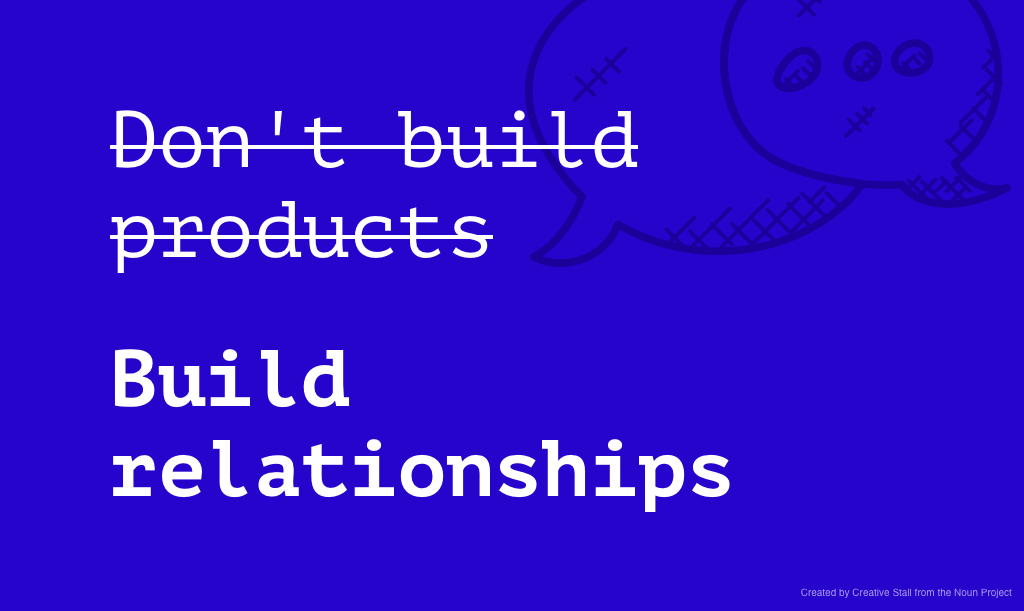I love building new products. The feeling of registering a fresh domain, the scribbled ideas in my notepad, the first prototypes. It just all feels so euphoric, so promising, so good.
What’s that you say? Oh yes, I’m aware I need to validate my idea, thank you. I have a landing page capturing leads, don’t you see? Besides, people have told me they really like my idea and they would pay for it!
Do I know my customer? Sure I do, I’ve spent days reading up on this new space I didn’t know anything about a week ago. Of course, I know my customer.
Will that be all? Can I go back to building my amazing product?
Pitching your idea to strangers is not validation
In the past, I’d validate my products by hitting up strangers online and asking them if they would have a minute to spare so I can pitch them my idea.
Let’s say I have a product idea for a newsletter service. The old me would put together a landing page and some mockups and head over to Twitter and DM anyone that has a newsletter trying to sell them into signing up for my non-existing product.
Validation - check done.
Not so fast, young man!
What have I learned? For one, I have a nice landing page and second, I can convince people to leave their email addresses.
That’s not a lot in terms of knowing if my product is solving an issue.
To be fair to this approach, it does give you some indication of interest. But if you get 0 to a few signups, can you tell why? Conversely, when you get hundreds of signups, do you know what part of your future product resonated the most? Do you know what to go build as an MVP?
To sum it up, there are two issues with this approach:
- You have to bother people with a selfish ask, giving them no value in return.
- You are framing the discussion by pitching your idea. You can only get a binary answer. Either they like it or they don’t. You learn very little about the customer and their pain points.
Forget about your product idea
Going back to our newsletter product idea. The first thing I need to do is to forget about the idea altogether. I’m just going to put it in a box, lock it, and bury the key in my backyard just in case.
Ideas are great, but they can be misleading. Just because they make sense on paper does not mean they will stand the test of the market. This was a hard one for me to appreciate.
Start by building relationships
If I’m excited about the newsletter space, the first thing I need to do is to build relationships with newsletter creators. In the online world, this happens on social media and in communities. Keevon Chueng calls this ‘making Twitter friends‘ and I love this mindset. He has an entire course on this and I highly recommend it.
To be clear, my goal is not to become best friends with newsletter creators (although that would be nice).
Rather, I think of it as a random act of kindness. Engaging with people by meaningfully replying to their tweets, sharing a useful resource related to a problem they’ve mentioned, signing up for their newsletter, and giving them my honest feedback.
People will appreciate your interest and you will start making friends.
Learn from your relationships
Once you are friends with a person, you can move to the next part — learning from them.
You are no longer reaching out to a stranger with a selfish ask. You are reaching out to a friend asking to learn from them. They will gladly spend 30 minutes on the phone telling you all they know.
Your goal is to get to know their tools, their processes, and their frustrations.
Build a mental model of their world. Dig deeper into anything that sounds inefficient, or that you’d do differently. Ask them why they are doing it the way they are. We are lazy creatures by nature and we will stick to our old ways just because it’s more comfortable.
The key is to find problems that are so painful and frustrating that a person is willing to change their old ways. These are tough to find, but they are the best problems to solve.
An automatic idea validator
The process of learning about your future users is an automatic idea validator. As you go deeper you will soon start to see if your idea solves a pain point, and more importantly, what you need to change so it solves their most pressing pain point.
The best part? In the process of validating you’ve also built an audience.
You will be in a position to build something useful and not launch it into a void.
But, you’re not done.
The obstacle is the way
Ryan Holiday writes in his book The Obstacle is the Way:
“The obstacle in the path becomes the path. Never forget, within every obstacle is an opportunity to improve our condition.”

Your product is never “validated“. You can never put a checkmark next to this task. Rather think of this obstacle as the path.
Products are a constant validation process. Every new feature you build and every feature you don’t build is an obstacle on the validation path.
Thanks to the relationships you’ve built early on, you’ve also given yourself the best companions on your validation path.
If you enjoyed reading this, follow me on Twitter for more thoughts about products and validation.


